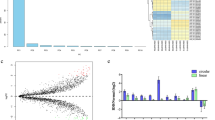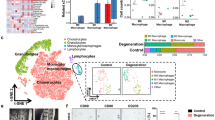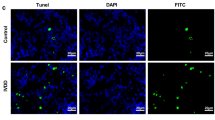Abstract
Intervertebral disc degeneration (IDD) is considered to be the leading cause of low back pain (LBP). The progression of IDD is closely related to the inflammatory microenvironment, which results in extracellular matrix degradation and cell death. One of the proteins, which have been shown to participate in the inflammatory response, is the bromodomain-containing protein 9 (BRD9). This study aimed to investigate the role and mechanism of BRD9 in regulating IDD. The tumor necrosis factor-α (TNF-α) was used to mimic the inflammatory microenvironment in vitro. Western blot, RT-PCR, immunohistochemistry, immunofluorescence, and flow cytometry were used to demonstrate the effect of BRD9 inhibition or knockdown on matrix metabolism and pyroptosis. We found that the expression of BRD9 was upregulated as IDD progressed. BRD9 inhibition or knockdown alleviated TNF-α-induced matrix degradation, reactive oxygen species (ROS) production, and pyroptosis in rat nucleus pulposus cells. Mechanistically, RNA-seq was used to investigate the mechanism of BRD9 in promoting IDD. Further investigation revealed that BRD9 regulated NOX1 expression. Inhibition of NOX1 could abrogate matrix degradation, ROS production, and pyroptosis caused by BRD9 overexpression. In vivo, the radiological and histological evaluation showed that the pharmacological inhibition of BRD9 alleviated IDD development in rat IDD model. Our results indicated that BRD9 could promote IDD via the NOX1/ROS/ NF-κB axis by inducing matrix degradation and pyroptosis. Targeting BRD9 may be a potential therapeutic strategy in treating IDD.









Similar content being viewed by others
Data Availability
The datasets generated during and/or analyzed during the current study are available from the corresponding author on reasonable request.
Materials Availability
The datasets generated during and/or analyzed during the current study are available from the corresponding author on reasonable request.
References
Deyo, R.A., and S.K. Mirza. 2016. CLINICAL PRACTICE. Herniated Lumbar Intervertebral Disk. New England Journal of Medicine 374 (18): 1763–72.
Hartvigsen, J., M.J. Hancock, A. Kongsted, Q. Louw, M.L. Ferreira, S. Genevay, et al. 2018. What low back pain is and why we need to pay attention. Lancet 391 (10137): 2356–2367.
Disease, G.B.D., I. Injury, and C. Prevalence. 2017. Global, regional, and national incidence, prevalence, and years lived with disability for 328 diseases and injuries for 195 countries, 1990–2016: A systematic analysis for the Global Burden of Disease Study 2016. Lancet 390 (10100): 1211–1259.
Wilson Zingg, R., and R. Kendall. 2017. Obesity, vascular disease, and lumbar disk degeneration: Associations of comorbidities in low back pain. PM & R : The Journal of Injury, Function, and Rehabilitation 9 (4): 398–402.
Livshits, G., M. Popham, I. Malkin, P.N. Sambrook, A.J. Macgregor, T. Spector, et al. 2011. Lumbar disc degeneration and genetic factors are the main risk factors for low back pain in women: The UK Twin Spine Study. Annals of the Rheumatic Diseases 70 (10): 1740–1745.
Roberts, S., H. Evans, J. Trivedi, and J. Menage. 2006. Histology and pathology of the human intervertebral disc. Journal of Bone and Joint Surgery. American Volume 88 (Suppl 2): 10–14.
Risbud, M.V., and I.M. Shapiro. 2014. Role of cytokines in intervertebral disc degeneration: Pain and disc content. Nature Reviews Rheumatology 10 (1): 44–56.
Wang, Y., M. Che, J. Xin, Z. Zheng, J. Li, and S. Zhang. 2020. The role of IL-1beta and TNF-alpha in intervertebral disc degeneration. Biomedicine & Pharmacotherapy 131: 110660.
Bertheloot, D., E. Latz, and B.S. Franklin. 2021. Necroptosis, pyroptosis and apoptosis: An intricate game of cell death. Cellular & Molecular Immunology 18 (5): 1106–1121.
Man, S.M., R. Karki, and T.D. Kanneganti. 2017. Molecular mechanisms and functions of pyroptosis, inflammatory caspases and inflammasomes in infectious diseases. Immunological Reviews 277 (1): 61–75.
Chen, F., G. Jiang, H. Liu, Z. Li, Y. Pei, H. Wang, et al. 2020. Melatonin alleviates intervertebral disc degeneration by disrupting the IL-1beta/NF-kappaB-NLRP3 inflammasome positive feedback loop. Bone Res. 8: 10.
Chen, S., X. Wu, Y. Lai, D. Chen, X. Bai, S. Liu, et al. 2022. Kindlin-2 inhibits Nlrp3 inflammasome activation in nucleus pulposus to maintain homeostasis of the intervertebral disc. Bone Res. 10 (1): 5.
Liao, Z., H. Liu, L. Ma, J. Lei, B. Tong, G. Li, et al. 2021. Engineering extracellular vesicles restore the impaired cellular uptake and attenuate intervertebral disc degeneration. ACS Nano 15 (9): 14709–14724.
Yan, J., S. Li, Y. Zhang, Z. Deng, J. Wu, Z. Huang, et al. 2021. Cholesterol induces pyroptosis and matrix degradation via mSREBP1-driven endoplasmic reticulum stress in intervertebral disc degeneration. Front Cell Dev Biol. 9: 803132.
Lloyd, J.T., and K.C. Glass. 2018. Biological function and histone recognition of family IV bromodomain-containing proteins. Journal of Cellular Physiology 233 (3): 1877–1886.
Boyson, S.P., C. Gao, K. Quinn, J. Boyd, H. Paculova, S. Frietze, et al. 2021. Functional roles of bromodomain proteins in cancer. Cancers (Basel) 13 (14).
Jain, A.K., and M.C. Barton. 2017. Bromodomain histone readers and cancer. Journal of Molecular Biology 429 (13): 2003–2010.
Hong, J., S. Li, D.Z. Markova, A. Liang, C.K. Kepler, Y. Huang, et al. 2020. Bromodomain-containing protein 4 inhibition alleviates matrix degradation by enhancing autophagy and suppressing NLRP3 inflammasome activity in NP cells. Journal of Cellular Physiology 235 (7–8): 5736–5749.
Li, S., Z. Huang, Y. Zhu, J. Yan, J. Li, J. Chen, et al. 2021. Bromodomain-containing protein 7 regulates matrix metabolism and apoptosis in human nucleus pulposus cells through the BRD7-PI3K-YAP1 signaling axis. Experimental Cell Research 405 (2): 112658.
Michel, B.C., A.R. D’Avino, S.H. Cassel, N. Mashtalir, Z.M. McKenzie, M.J. McBride, et al. 2018. A non-canonical SWI/SNF complex is a synthetic lethal target in cancers driven by BAF complex perturbation. Nature Cell Biology 20 (12): 1410–1420.
Brien, G.L., D. Remillard, J. Shi, M.L. Hemming, J. Chabon, K. Wynne, et al. 2018. Targeted degradation of BRD9 reverses oncogenic gene expression in synovial sarcoma. Elife 7.
Zhang, C., L. Chen, W. Lou, J. Su, J. Huang, A. Liu, et al. 2021. Aberrant activation of m6A demethylase FTO renders HIF2alpha(low/-) clear cell renal cell carcinoma sensitive to BRD9 inhibitors. Science Translational Medicine 13 (613): eabf6045.
Mu, J., X. Sun, Z. Zhao, H. Sun, and P. Sun. 2021. BRD9 inhibition promotes PUMA-dependent apoptosis and augments the effect of imatinib in gastrointestinal stromal tumors. Cell Death & Disease 12 (11): 962.
Ahmed, N.S., J. Gatchalian, J. Ho, M.J. Burns, N. Hah, Z. Wei, et al. 2022. BRD9 regulates interferon-stimulated genes during macrophage activation via cooperation with BET protein BRD4. Proceeding of the National Academy of Science USA 119 (1).
Wei, Z., E. Yoshihara, N. He, N. Hah, W. Fan, A.F.M. Pinto, et al. 2018. Vitamin D switches BAF complexes to protect beta cells. Cell 173 (5): 1135–49 e15.
Zhao, Y., C. Qiu, W. Wang, J. Peng, X. Cheng, Y. Shangguan, et al. 2020. Cortistatin protects against intervertebral disc degeneration through targeting mitochondrial ROS-dependent NLRP3 inflammasome activation. Theranostics. 10 (15): 7015–7033.
Bedard, K., and K.H. Krause. 2007. The NOX family of ROS-generating NADPH oxidases: Physiology and pathophysiology. Physiological Reviews 87 (1): 245–313.
Liu, G., Q. Liu, B. Yan, Z. Zhu, and Y. Xu. 2020. USP7 Inhibition alleviates H2O2-induced injury in chondrocytes via inhibiting NOX4/NLRP3 pathway. Frontiers in Pharmacology 11: 617270.
Wang, K., L. Kang, W. Liu, Y. Song, X. Wu, Y. Zhang, et al. 2018. Angiopoietin-2 promotes extracellular matrix degradation in human degenerative nucleus pulposus cells. International Journal of Molecular Medicine 41 (6): 3551–3558.
Cheng, X., J. Lin, Z. Chen, Y. Mao, X. Wu, C. Xu, et al. 2021. CB2-mediated attenuation of nucleus pulposus degeneration via the amelioration of inflammation and oxidative stress in vivo and in vitro. Molecular Medicine 27 (1): 92.
Mai, W., Y. Xu, J. Xu, D. Zhao, L. Ye, G. Yu, et al. 2020. Berberine inhibits nod-like receptor family pyrin domain containing 3 inflammasome activation and pyroptosis in nonalcoholic steatohepatitis via the ROS/TXNIP axis. Frontiers in Pharmacology 11: 185.
Wu, X., H. Zhang, W. Qi, Y. Zhang, J. Li, Z. Li, et al. 2018. Nicotine promotes atherosclerosis via ROS-NLRP3-mediated endothelial cell pyroptosis. Cell Death & Disease 9 (2): 171.
Sandoval, R., P. Lazcano, F. Ferrari, N. Pinto-Pardo, C. Gonzalez-Billault, and E. Utreras. 2018. TNF-alpha increases production of reactive oxygen species through Cdk5 activation in nociceptive neurons. Frontiers in Physiology 9: 65.
Kim, Y.S., M.J. Morgan, S. Choksi, and Z.G. Liu. 2007. TNF-induced activation of the Nox1 NADPH oxidase and its role in the induction of necrotic cell death. Molecular cell. 26 (5): 675–687.
Zhang, G.Z., H.W. Chen, Y.J. Deng, M.Q. Liu, Z.L. Wu, Z.J. Ma, et al. 2022. BRD4 inhibition suppresses senescence and apoptosis of nucleus pulposus cells by inducing autophagy during intervertebral disc degeneration: An in vitro and in vivo study. Oxidative Medicine and Cellular Longevity 2022: 9181412.
Dou, C., L. Sun, L. Wang, J. Cheng, W. Wu, C. Zhang, et al. 2020. Bromodomain-containing protein 9 promotes the growth and metastasis of human hepatocellular carcinoma by activating the TUFT1/AKT pathway. Cell Death & Disease 11 (9): 730.
Wang, L., T.G. Oh, J. Magida, G. Estepa, S.M.B. Obayomi, L.W. Chong, et al. 2021. Bromodomain containing 9 (BRD9) regulates macrophage inflammatory responses by potentiating glucocorticoid receptor activity. Proceedings of the National Academy of Sciences USA 118 (35).
Theodoulou, N.H., P. Bamborough, A.J. Bannister, I. Becher, R.A. Bit, K.H. Che, et al. 2016. Discovery of I-BRD9, a selective cell active chemical probe for bromodomain containing protein 9 inhibition. Journal of Medicinal Chemistry 59 (4): 1425–1439.
Martin, L.J., M. Koegl, G. Bader, X.L. Cockcroft, O. Fedorov, D. Fiegen, et al. 2016. Structure-based design of an in vivo active selective BRD9 inhibitor. Journal of Medicinal Chemistry 59 (10): 4462–4475.
Remillard, D., D.L. Buckley, J. Paulk, G.L. Brien, M. Sonnett, H.S. Seo, et al. 2017. Degradation of the BAF complex factor BRD9 by heterobifunctional ligands. Angewandte Chemie (International ed. in English) 56 (21): 5738–5743.
Zhou, Y., Z. Chen, X. Yang, X. Cao, Z. Liang, H. Ma, et al. 2021. Morin attenuates pyroptosis of nucleus pulposus cells and ameliorates intervertebral disc degeneration via inhibition of the TXNIP/NLRP3/caspase-1/IL-1beta signaling pathway. Biochemical and Biophysical Research Communications 559: 106–112.
Zeng, C., F. Duan, J. Hu, B. Luo, B. Huang, X. Lou, et al. 2020. NLRP3 inflammasome-mediated pyroptosis contributes to the pathogenesis of non-ischemic dilated cardiomyopathy. Redox Biology 34: 101523.
An, H., J.S. Heo, P. Kim, Z. Lian, S. Lee, J. Park, et al. 2021. Tetraarsenic hexoxide enhances generation of mitochondrial ROS to promote pyroptosis by inducing the activation of caspase-3/GSDME in triple-negative breast cancer cells. Cell Death & Disease 12 (2): 159.
Dou, C., Q. Xu, J. Liu, Y. Wang, Z. Zhou, W. Yao, et al. 2019. SHMT1 inhibits the metastasis of HCC by repressing NOX1-mediated ROS production. Journal of Experimental & Clinical Cancer Research 38 (1): 70.
Koju, N., A. Taleb, J. Zhou, G. Lv, J. Yang, X. Cao, et al. 2019. Pharmacological strategies to lower crosstalk between nicotinamide adenine dinucleotide phosphate (NADPH) oxidase and mitochondria. Biomedicine & Pharmacotherapy 111: 1478–1498.
Fukai, T., and M. Ushio-Fukai. 2020. Cross-talk between NADPH oxidase and mitochondria: Role in ROS signaling and angiogenesis. Cells 9 (8).
Doughan, A.K., D.G. Harrison, and S.I. Dikalov. 2008. Molecular mechanisms of angiotensin II-mediated mitochondrial dysfunction: Linking mitochondrial oxidative damage and vascular endothelial dysfunction. Circulation Research 102 (4): 488–496.
Lee, S.B., I.H. Bae, Y.S. Bae, and H.D. Um. 2006. Link between mitochondria and NADPH oxidase 1 isozyme for the sustained production of reactive oxygen species and cell death. Journal of Biological Chemistry 281 (47): 36228–36235.
Matsumoto, M., J. Liu, K. Iwata, M. Ibi, N. Asaoka, X. Zhang, et al. 2021. NOX1/NADPH oxidase is involved in the LPS-induced exacerbation of collagen-induced arthritis. Journal of Pharmacological Sciences 146 (2): 88–97.
He, J., K. Chen, T. Deng, J. Xie, K. Zhong, J. Yuan, et al. 2021. Inhibitory effects of rhaponticin on osteoclast formation and resorption by targeting RANKL-induced NFATc1 and ROS activity. Frontiers in Pharmacology 12: 645140.
Hayden, M.S., and S. Ghosh. 2008. Shared principles in NF-kappaB signaling. Cell 132 (3): 344–362.
Zhang, G.Z., M.Q. Liu, H.W. Chen, Z.L. Wu, Y.C. Gao, Z.J. Ma, et al. 2021. NF-kappaB signalling pathways in nucleus pulposus cell function and intervertebral disc degeneration. Cell Proliferation 54 (7): e13057.
Jimi, E., and T. Katagiri. 2022. Critical roles of NF-kappaB signaling molecules in bone metabolism revealed by genetic mutations in osteopetrosis. International Journal of Molecular Sciences 23 (14).
Acknowledgements
We thank Bullet Edits Limited for editing and proofreading of the article.
Funding
This work was supported by the grants from the National Natural Science Foundation of China (Nos. 81572197 and 82002776), the Natural Science Foundation of Guangdong Province (Nos. 2020A1515011538 and 2020A1515010060), the Guangdong Basic and Applied Basic Research Foundation (No. 2021A1515010345), and the Yat-sen Qihang Foundation of Sun Yat-sen memorial hospital (No. YXQH202204).
Author information
Authors and Affiliations
Contributions
WY, DSH, and WJC conceived and designed the study. ZHD, YYZ, and YXZ performed experiments; JXZ and SXL prepared figures; ZQH and TYQ analyzed data; JJW and CZ helped to write and revise the manuscript. All the authors read and approved the final manuscript.
Corresponding author
Ethics declarations
Ethics Approval
The usage of human samples was approved by the Ethics Committee of Sun Yat-Sen Memorial Hospital [No. (2022) 413]. The animal study was approved by Institutional Animal Care and Use Committee of Sun Yat-sen University (SYSU-IACUC-2022-B1211).
Consent to Participate
Informed consent was obtained from all individual participants included in the study.
Consent for Publication
The authors affirm that human research participants provided informed consent for publication of Table 1, Fig. 1a and b, and Fig. 5c.
Competing Interests
The authors declare no competing interests.
Additional information
Publisher's Note
Springer Nature remains neutral with regard to jurisdictional claims in published maps and institutional affiliations.
Supplementary Information
Below is the link to the electronic supplementary material.
Rights and permissions
Springer Nature or its licensor (e.g. a society or other partner) holds exclusive rights to this article under a publishing agreement with the author(s) or other rightsholder(s); author self-archiving of the accepted manuscript version of this article is solely governed by the terms of such publishing agreement and applicable law.
About this article
Cite this article
Deng, Z., Zhang, Y., Zhu, Y. et al. BRD9 Inhibition Attenuates Matrix Degradation and Pyroptosis in Nucleus Pulposus by Modulating the NOX1/ROS/NF-κB axis. Inflammation 46, 1002–1021 (2023). https://doi.org/10.1007/s10753-023-01786-6
Received:
Revised:
Accepted:
Published:
Issue Date:
DOI: https://doi.org/10.1007/s10753-023-01786-6




